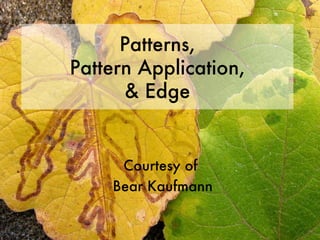Patterns edgesystems
- 1. Patterns, Pattern Application, & Edge Courtesy of Bear Kaufmann
- 3. Concentric: Growth Tree Rings
- 4. Concentric: Growth Through Accretion Agate
- 5. Too Hot Too Cold You Are Here Solar System: Not To Scale Concentric: Radiating & Diffusing Energy
- 6. ╠²
- 7. ╠²
- 8. Radial Patterns Collection Lupine - Lupinus polyphyllus
- 9. Spiral Patterns MedusaŌĆÖs Head Cactus - Euphorbia caput-medusae
- 10. Spirals: For Growth Tide Pool
- 11. Spirals in 3D: Helixes Chayote Squash - Sechium edule
- 12. The Spiral Note that each new square has a side which is as long as the sum of the latest two square's sides .
- 13. A M B The line AB is divided at point M so that the ratio of the two parts, the smaller MB to the larger AM is the same as the ratio of the larger part AM to the whole AB. One Way to Understand It
- 15. Oak Tree - Quercus spp. Spirals in 3D: Helixes
- 16. Argentinian Coast Spirals: Turbulent Flow earthobservatory.nasa.gov
- 17. Interlocking Spirals: von Karman vortex streets earthobservatory.nasa.gov
- 22. Spirals in Time Disturbance Wave Patterns
- 23. Spirals in Time Disturbance Wave Patterns
- 24. Turbulence
- 26. Effects of Flow
- 27. Flow
- 28. Crenulations
- 32. Surface Area to Volume
- 33. Bucky
- 34. Fractals: fractus = part
- 35. Fractals: systems inside systems patterns within patterns
- 36. Measuring Coastline: Mandelbrot, Fractals, and Edge earth.google.com ŌĆ£ Clouds are not spheres, mountains are not cones, coastlines are not circles, and bark is not smooth, nor does lightning travel in a straight line.ŌĆØ - Beno├«t B. Mandelbrot
- 37. Edible Fractals
- 39. Edge The interface between two ecosystems represents a third, more complex, system which combines both.
- 40. Gradients: the rate of transition Pressure Temperature Acidity Elevation & other properties
- 41. Branches & Networks Grape Leaf
- 42. Branches Fennel
- 43. Leaves and Branching Leaves are also found in groups of Fibonacci numbers. Branching plants always branch off into groups of Fibonacci numbers.
- 44. Beech Tree Branching: Dendritic
- 45. Low Diffusion Low Friction Higher Diffusion High Friction Most Diffusion For Least Friction Branches: For Diffusion and Accumulation
- 46. Branches: oldest oaks have 7 orders
- 47. Branches: Watersheds and Tributaries Oakland Hills - Digital Elevation Model
- 48. Branches: Water Flow Jordan earthobservatory.nasa.gov
- 49. Networks
- 51. Centralized Decentralized Network Topology Adapted from Linked by A. Barab├Āsi
- 52. ╠²
Editor's Notes
- #2: 1. Intro 2. Questions: a. Limited time. If we have time IŌĆÖll answer them after the discussion. 3. Why Patterns? a. Better designs b. Understand phenomena c. Patterns, pattern language i. repeating themes throughout design, by humans, or in nature
- #3: Zones Urban planning - ŌĆ£the urban coreŌĆØ
- #4: Tree rings dendrochronology
- #5: Like tree rings, different medium
- #6: All scales
- #9: Sectors Many plants in dry ecosystems develops forms to concentrate water near their roots Bus Rapid Transit arterial systems
- #10: Galaxies Sunflowers Turbulence
- #11: No matter how large, the shape remains the same Accreting shell on the outer lip to grow
- #12: Tenacity Flexiblity/Spring
- #16: Some trees grow in a helical form Classic Example - DNA - compact information storage
- #17: Algae growth off Agentina Ocean currents, Mixing of Two Concentrations
- #18: Mushroom forms
- #25: Mixing / Entropy
- #26: Compare with human intestines
- #27: Streamline forms from fluids
- #29: in lichens, at reef edges A very small notch or indentation
- #31: 2x more edge. More food. More fish.
- #37: Hired by the British govt to measure the coastline of Britian. Surface Area At each level of detail, the length got larger, approaching infinity. 1. Pro - more interface for the amount of area, like intestines a. Humid/Temperate Climates - Trees with 10-30 acres of edge. b. Con - more edge = more material, material conserving designs (like geodesic, bubbles) Arid Climates - Barrel Cactus, round like a geodesic dome, little edge, low water loss. In desert climates: make deep pond with low surface area.
- #40: Edge or Surface Area ŌĆ£BoundariesŌĆØ, Interfaces betweeen various conditions Most fertile areas are edges (conceptually, and in the environmental, intertidal zones)
- #41: Pressure = winds Elevation = erosion, water speed The sweet spot. Walls. Soft or Sharp Adding slower transitions for varied species
- #43: Branches never reconnect Evolutionary decent? Gene swapping. Microbial life?
- #45: Neurons - ŌĆ£dendritesŌĆØ - dentrites link together to form network Branches - high average cost from point to point Slow communication: bureaucracy
- #46: Common form in nature Why? What are the reasons? Flow could be in reverse.
- #47: Orders - each size Rivlet, Creek, Stream, River, EstuaryŌĆ”
- #48: Water - the path of least resistance DoesnŌĆÖt store water Flows both ways: Water Sediment Downstream / Salmon Nutrients Upstream Nitrogen
- #49: Note the stream lines. Low gradients?
- #50: Contraction Expansive clay social networks mycelium
- #51: Are we recognizing patterns yet? The US at night. Long exposure.
- #52: The Internet. Which is Resiliant? Scale-free/Small world = few hops to any node in the network Scale-free can scale without a loss in quality Explain bell and power law curves. Hubs and Keystone species




















































